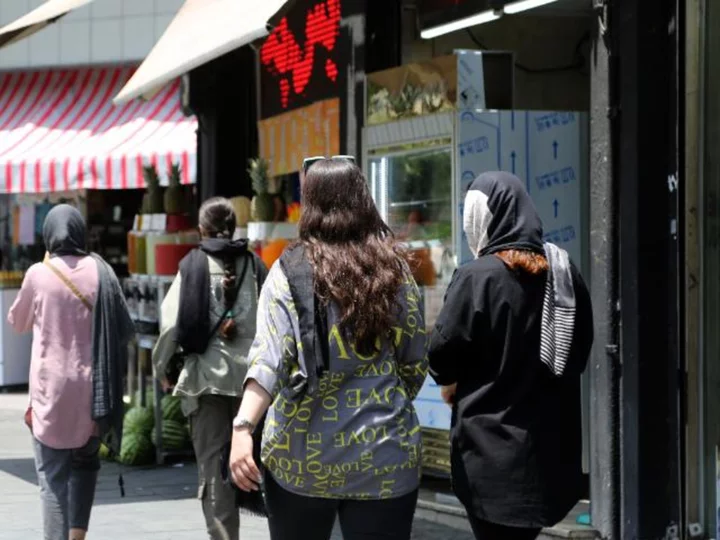Just weeks ahead of the one-year anniversary of the mass protests sparked by the death of Mahsa Amini, Iranian authorities are considering a draconian new bill on hijab-wearing that experts say would enshrine unprecedentedly harsh punitive measures into law.
The 70-article draft law sets out a range of proposals, including much longer prison terms for women who refuse to wear the veil, stiff new penalties for celebrities and businesses who flout the rules, and the use of artificial intelligence to identify women in breach of the dress code.
Experts said the bill, which has not yet been passed, was a warning to Iranians that the regime would not back down from its stance on the hijab despite the mass demonstrations that rocked the country last year.
The bill was submitted by the judiciary to the government for consideration earlier this year, then forwarded to the parliament and subsequently approved by the Legal and Judicial Commission. It is set to be submitted to the Board of Governors this Sunday before it is introduced on the floor of parliament, state-aligned news agency Mehr reported Tuesday.
Iran's parliament would work on finalizing the text and voting on the bill "in the next two months," Mehr said. It is "a clear response to the protests from September of last fall," Sanam Vakil, director of the Middle East and North Africa program at the Chatham House think-tank in London, told CNN, adding that the establishment was attempting to "reassert authority over veiling and the requirements expected of women."
Amini, a 22-year-old Kurdish-Iranian woman, died last September after being detained by the regime's infamous morality police and taken to a "re-education center," allegedly for not abiding by the country's conservative dress code.
While not officially disbanded, the morality police had largely pulled back following last year's protests, which have gradually waned. But earlier this month, police spokesman General Saeed Montazerolmahdi said the morality police would resume notifying and then detaining women who are caught without the Islamic headscarf in public.
Extreme punitive measures
The hijab has long been a point of contention in Iran. It was barred in 1936 during leader Reza Shah's emancipation of women, until his successor lifted the ban in 1941. In 1983 the hijab became mandatory after the last shah was overthrown in the Islamic Revolution of 1979.
Iran has traditionally considered Article 368 of its Islamic penal code as the hijab law, which states that those in breach of the dress code face between 10 days to two months in prison, or a fine between 50,000 to 500,000 Iranian rials, what is today between $1.18 to $11.82.
The new bill would reclassify failure to wear the hijab as a more severe offense, punishable by a five-to-ten-year prison sentence as well as a higher fine of up to 360 million Iranian rials ($8,508).
That fine is far beyond what the average Iranian could pay, as millions are below the poverty line, Hossein Raeesi, an Iranian human rights lawyer and adjunct professor at Carleton University in Ottawa, Canada, told CNN.
Another section states that in order to enforce the new law, Iranian police must "create and strengthen AI systems to identify perpetrators of illegal behavior using tools such as fixed and mobile cameras." Earlier this year, state media reported that cameras would be installed in public places to identify women who violate the country's hijab law.
Under the new law, business owners who do not enforce the hijab requirement will face steeper fines, potentially amounting to three months' of their business profit, and face bans on leaving the country or participating in public or cyberactivity for up to two years.
The bill also targets celebrities, who may face a fine of up to a tenth of their wealth, exclusion from employment or professional activities for a specified period of time, as well as a ban on international travel and social media activities.
The draft law would also mandate broader gender segregation in universities -- common hotbeds of civilian protests -- and other public spaces.
Article 49 of the bill defines the lack of hijab for women as "clothes that show a part of the body below the neck or above the ankles or above the forearms." Clothes that are "revealing or tight" also violate the law.
Some of the measures in the draft law have already been "unlawfully" exercised by the Iranian security forces, Raeesi said, including the recent closure of an insurance company in Tehran after some photos of female employees without the hijab circulated on social media. With this bill, the government would "legalize illegal behavior" by those forces, Raeesi said.
Experts believe the legislation, or parts of it, is likely to pass in some form -- most members of parliament are regime-aligned and unlikely to block it -- though Raeesi said it was possible that the government could pull the bill if it is able to control any potential unrest around the Mahsa Amini anniversary. If the bill is passed by parliament, it must also be approved by the regime's Guardian Council, Raeesi told CNN.
A 12-member council with considerable power in Iran, the Guardian Council is charged with making sure that legislation passed falls in line with the values of Islam and the Iranian constitution. Any bill passed by the parliament must be reviewed and approved by the council to become law.
In the meantime, experts said the bill sent a clear message to Iranians.
"The system is trying to make clear that leniency won't be tolerated, and that there is a clear, graduated system of punishment for individuals that are going to flout the dress law in the country," Vakil said.

